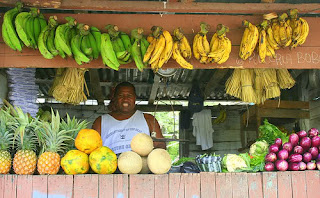Dominican Republic culture people food and festivals
The Dominican people and their customs have origins consisting predominately in a European cultural basis, with bothAfrican and native Taíno influences.[1] The Dominican Republic was the site of the first European settlement in the New World, namely Santo Domingo, founded in 1493.
Shortly after the arrival of Europeans, African peoples were imported to the island to serve as slave labor. The fusion of European, African and Taino traditions and customs contributed to the development of present-day Dominican culture.
Dominican Republic cuisine is predominantly made up of a combination of Spanish, indigenous Taíno, and African influences. Many Middle-Eastern dishes have been adopted into Dominican cuisine, such as the "Quipe" that comes from the Lebanese kibbeh. Dominican cuisine resembles that of other countries in Latin America, those of the nearby islands of Puerto Rico and Cuba, most of all, though the dish names differ sometimes.
A traditional breakfast would consist of mangú, sauteed onions, fried eggs, fried salami, fried cheese and sometimes avocado. This is called "Los Tres Golpes" or "The Three Hits". As in Spain, the largest, most important meal of the day is lunch. Its most typical form, nicknamed La Bandera ("The Flag"), consists of rice, red beans and meat (beef, chicken, pork, or fish), sometimes accompanied by a side of salad.
In only seven years, the Dominican Republic's fashion week has become the most important event of its kind in all of the Caribbean and one of the fastest growing fashion events in the entire Latin American fashion world. The country boasts one of the ten most important design schools in the region, La Escuela de Diseño de Altos de Chavón, which is making the country a key player in the world of fashion and design.
World famous fashion designer Oscar de la Renta was born in the Dominican Republic in 1932, and became a US citizen in 1971. He studied under the leading Spaniard designer Cristóbal Balenciaga and then worked with the house of Lanvin in Paris. Then by 1963, de la Renta had designs carrying his own label. After establishing himself in the US, de la Renta opened boutiques across the country. His work blends French and Spaniard fashion with American styles
The many kinds of religion in the Dominican Republic have been growing and changing. Historically, Catholicism dominated the religious practices of the small country. In modern times Protestant and non-Christian groups, like Buddhists, Jews, and Muslims, have experienced a population boom.
During the last week of July and first week of August Santo Domingo hosts some of the world's top merengue bands at the Festival del Merengue. Other events during the two-week-long party include and food festival and an arts and crafts festival.



















No comments:
Post a Comment